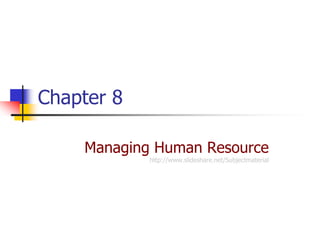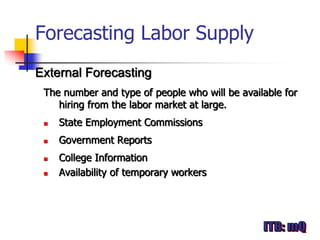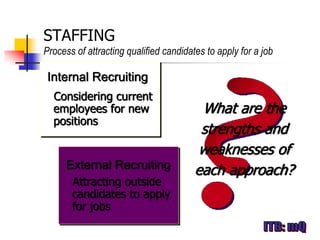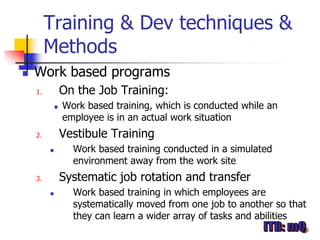Chap 8 managing hr
- 1. Chapter 8 Managing Human Resource http://www.slideshare.net/Subjectmaterial
- 2. Quiz And All the MoMs you can eat P-206 1,4,5,6, 2
- 3. FINAL PROJECT GENERATE REVENUE REQUIRED SUBMIT GROUP NAMES DATE OF IDEA SUBMISSION 3
- 4. Marks Distribution 50 Terminal Examination 20 Mid Term Examination 15 Quizzes 15 Final Assignment 4
- 5. 1. THE FOUNDATION OF HRM The Strategic importance of HRM Human Resource Planning 2. STAFFING THE ORGANIZATION Selecting Human Resource 3. DEVELOPING HUMAN RESOURCES Orientation Training & Development Techniques and methods 4. EVALUATING EMPLOYEE PERFORMANCE 5. PROVIDING COMPENSATION AND BENEFITS Compensation Indirect compensation and benefits 6. THE LEGAL CONTEXT OF HRM Equal employment opportunity Contemporary legal issues in HRM
- 6. 7. NEW CHALLENGES IN THE CHANGING WORKPLACE Managing workforce diversity Managing knowledge workers Contingent and temporary workers Reference: Teacher tools
- 7. THE FOUNDATIONS OF HRM HRM: Attracting, developing, and maintaining an effective workforce 7
- 8. Human Resource Planning Process Forecast demand for labor Conduct analysis Forecast internal supply of labor Forecast external Develop plan to supply of match demand labor with supply
- 9. Job Analysis “systematic analysis of Jobs Within an organization” Job Description: Systematic evaluation of the duties, working conditions, tools, materials, and equipment related to the performance of a job Job Specification: Description of the skills, abilities, and other credentials required by a job
- 10. Forecasting Labor Supply Internal Forecasting: The number and type of employees who will be in the organization in some future date Replacement Charts Listing of each managerial position, who occupies it, how long that person will likely stay in the job, and who is qualified as a replacement Skills Inventories (Emp Information Sys) Computerized system containing info on each employee’s education, skills, work experiences, and career aspirations
- 11. Forecasting Labor Supply External Forecasting The number and type of people who will be available for hiring from the labor market at large. State Employment Commissions Government Reports College Information Availability of temporary workers
- 12. Matching HR Supply and Demand Dealing with predicted shortfall Find out through comparing future demand and internal supply Hire new employees Consider hiring temporary workers Retrain and transfer current employees into understaffed areas Productivity enhancing systems Convince older workers not to retire Dealing with overstaffing: Transfer the extra employees to other teams Not providing replacements Encourage early retirement Lay offs
- 13. STAFFING Process of attracting qualified candidates to apply for a job Internal Recruiting Considering current employees for new What are the positions strengths and weaknesses of External Recruiting each approach? Attracting outside candidates to apply for jobs
- 14. Selecting Human Resources Objective: To gather information that will predict their job success and then to hire the candidates likely to be most successful Process Application Forms Tests Interviews
- 15. DEVELOPING HUMAN RESOURCES Orientation: Process of introducing new employees to the organization so that they can quickly become effective contributors 15
- 16. Training & Dev techniques & Methods Work based programs 1. On the Job Training: Work based training, which is conducted while an employee is in an actual work situation 2. Vestibule Training Work based training conducted in a simulated environment away from the work site 3. Systematic job rotation and transfer Work based training in which employees are systematically moved from one job to another so that they can learn a wider array of tasks and abilities 16
- 17. Training & Dev techniques & Methods Instructional based program Training designed to impart new knowledge and information 1. Lecture or discussion Instructional based training in which knowledge and information are descriptively presented 2. Computer assisted instruction Instruction based training in which knowledge and information are presented via computer 17
- 18. Training & Dev techniques & Methods Training Technology Video Teleconferencing Interactive Video Team building and Group based Training Cooperation and group learning Outdoor programs Leadership programs Physical activities 18
- 19. EVALUATING EMPLOYEE PERFORMANCE Performance Appraisal Formal evaluation of an employee’s job performance in order to determine the degree to which the employee is performing effectively
- 20. PROVIDING COMPENSATION AND BENEFITS Compensation: Set of rewards that organizations provide to individuals in-return, for their willingness to perform various jobs and tasks. Elements of Compensation Base salary Incentives Bonuses Benefits Other rewards 20
- 21. Compensation Wages: Compensation in the form of money paid for time worked Salary Compensation in the form of money paid for performing the responsibilities of a job Merit pay plan Performance based pay plan which are formally based on at least some meaningful portion of compensation on merit 21
- 22. Indirect Compensation & Benefits Benefits: Compensation other than wages and salaries like rewards, incentives and other things of value Mandated protection plans Unemployment insurance Social security; pension plans, provident fund Optional protection plans Health insurance (dentals, maternity, death coverage etc) Private pension plans Paid time off; 22 paid vacations, sick and annual leaves
- 23. Other types of Benefits Wellness programs Counseling services Childcare benefits Cafeteria benefits; set limit on benefits per employee, giving employee to choose from a variety of alternative benefits Fitness centers, sports, pick n drop, educational assistance
- 24. THE LEGAL CONTEXT OF HR MANAGEMENT 24
- 25. Equal Employment opportunity Equal employment opportunity: Legally mandated nondiscrimination in employment on the basis of race, religion, gender or national origin Illegal discrimination Discrimination against protected classes that cause them to be unfairly differentiated from others Protected Class: 25 Like women, black, disabled
- 26. Contemporary issues in HR management Employee safety and health Sexual Harrasment Employment at will 26
- 27. NEW CHALLENGES IN THE WORKPLACE Managing workforce diversity Managing knowledge workers Contingent and temporary workers 27
Editor's Notes
- http://www.slideshare.net/Subjectmaterial


























